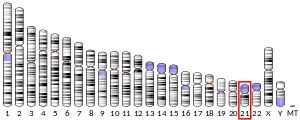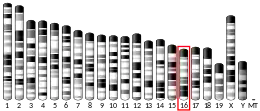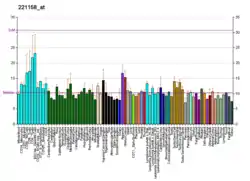PAXBP1
GC-rich sequence DNA-binding factor homolog is a protein that in humans is encoded by the PAXBP1 gene.[5][6][7]
Similarity to a transcriptional repressor suggests that this gene's protein product is involved in the regulation of transcription. Alternative splicing of this gene results in three transcript variants encoding different isoforms. Additional transcript variants have been described, but their full-length sequences have not been determined.[7]
References
- ENSG00000263141 GRCh38: Ensembl release 89: ENSG00000159086, ENSG00000263141 - Ensembl, May 2017
- GRCm38: Ensembl release 89: ENSMUSG00000022974 - Ensembl, May 2017
- "Human PubMed Reference:". National Center for Biotechnology Information, U.S. National Library of Medicine.
- "Mouse PubMed Reference:". National Center for Biotechnology Information, U.S. National Library of Medicine.
- Zhang QH, Ye M, Wu XY, Ren SX, Zhao M, Zhao CJ, Fu G, Shen Y, Fan HY, Lu G, Zhong M, Xu XR, Han ZG, Zhang JW, Tao J, Huang QH, Zhou J, Hu GX, Gu J, Chen SJ, Chen Z (Nov 2000). "Cloning and functional analysis of cDNAs with open reading frames for 300 previously undefined genes expressed in CD34+ hematopoietic stem/progenitor cells". Genome Res. 10 (10): 1546–60. doi:10.1101/gr.140200. PMC 310934. PMID 11042152.
- Reymond A, Friedli M, Henrichsen CN, Chapot F, Deutsch S, Ucla C, Rossier C, Lyle R, Guipponi M, Antonarakis SE (Nov 2001). "From PREDs and open reading frames to cDNA isolation: revisiting the human chromosome 21 transcription map". Genomics. 78 (1–2): 46–54. doi:10.1006/geno.2001.6640. PMID 11707072.
- "Entrez Gene: C21orf66 chromosome 21 open reading frame 66".
External links
- Human PAXBP1 genome location and PAXBP1 gene details page in the UCSC Genome Browser.
Further reading
- Slavov D, Hattori M, Sakaki Y, et al. (2000). "Criteria for gene identification and features of genome organization: analysis of 6.5 Mb of DNA sequence from human chromosome 21". Gene. 247 (1–2): 215–32. doi:10.1016/S0378-1119(00)00089-5. PMID 10773462.
- Strausberg RL, Feingold EA, Grouse LH, et al. (2003). "Generation and initial analysis of more than 15,000 full-length human and mouse cDNA sequences". Proc. Natl. Acad. Sci. U.S.A. 99 (26): 16899–903. Bibcode:2002PNAS...9916899M. doi:10.1073/pnas.242603899. PMC 139241. PMID 12477932.
- Ota T, Suzuki Y, Nishikawa T, et al. (2004). "Complete sequencing and characterization of 21,243 full-length human cDNAs". Nat. Genet. 36 (1): 40–5. doi:10.1038/ng1285. PMID 14702039.
- Beausoleil SA, Jedrychowski M, Schwartz D, et al. (2004). "Large-scale characterization of HeLa cell nuclear phosphoproteins". Proc. Natl. Acad. Sci. U.S.A. 101 (33): 12130–5. Bibcode:2004PNAS..10112130B. doi:10.1073/pnas.0404720101. PMC 514446. PMID 15302935.
- Kimura K, Wakamatsu A, Suzuki Y, et al. (2006). "Diversification of transcriptional modulation: large-scale identification and characterization of putative alternative promoters of human genes". Genome Res. 16 (1): 55–65. doi:10.1101/gr.4039406. PMC 1356129. PMID 16344560.
- Hu YH, Warnatz HJ, Vanhecke D, et al. (2006). "Cell array-based intracellular localization screening reveals novel functional features of human chromosome 21 proteins". BMC Genomics. 7: 155. doi:10.1186/1471-2164-7-155. PMC 1526728. PMID 16780588.
- Olsen JV, Blagoev B, Gnad F, et al. (2006). "Global, in vivo, and site-specific phosphorylation dynamics in signaling networks". Cell. 127 (3): 635–48. doi:10.1016/j.cell.2006.09.026. PMID 17081983. S2CID 7827573.
This article is issued from Wikipedia. The text is licensed under Creative Commons - Attribution - Sharealike. Additional terms may apply for the media files.





